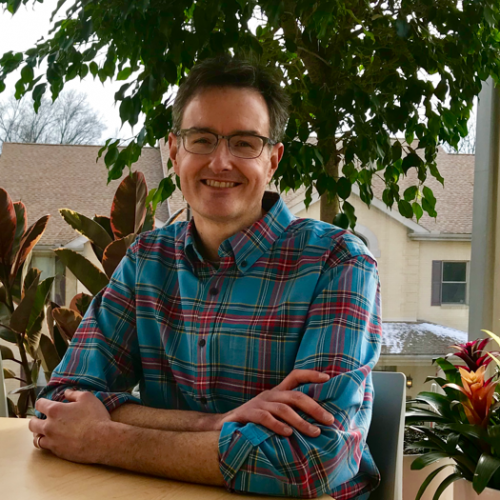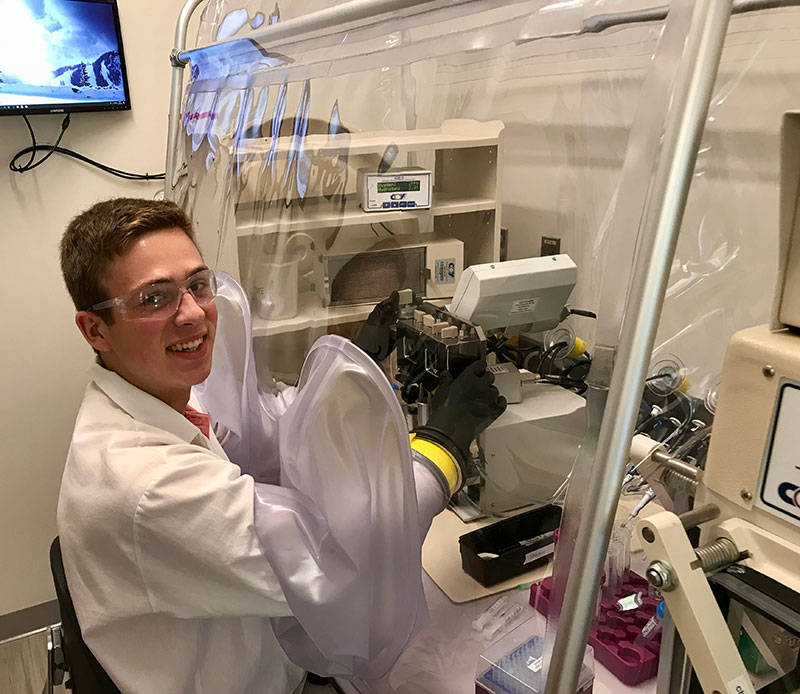
Longtime research identifies enzyme’s role in removing contaminants from the environment

Mark Snider, Robert E. Wilson Professor of Chemistry and Biochemistry and Molecular Biology at The College of Wooster, has identified the kinetic mechanism of a novel flavin monooxygenase, known as NicC. This enzyme plays a role in the degradation pathway in bacteria that allows the bacteria to remove pervasive contaminants from the soil ecosystem. The contaminants come from personal care products, pharmaceuticals, and industrial processes. NicC is also an enzyme Snider and his collaborators have studied for the past 15 years.
Snider’s research has produced three journaled papers thus far, with the most recent publication, “Mechanism of the multistep catalytic cycle of 6-hydroxynicotinate 3-monooxygenase revealed by global kinetic analysis,” published in the May 2, 2023, American Chemistry Society’s journal Biochemistry. The paper was a collaborative effort including two former Wooster biochemistry and molecular biology students—Scott Perkins ’20 and May Hlaing ’22—and two research collaborators. Through the research, they developed and optimized the experimental parameters to determine the structure and rate of interconversion of each intermediate (i.e. the kinetic mechanism) within the enzyme’s 10-step catalytic cycle.

Scott Perkins ’20 collaborated with Snider as an experimentalist and produced an Independent Study thesis that helped bring about the publication.
“The experimental work was challenging, and quite unique for undergraduates to experience, but both students were remarkable experimentalists and produced excellent I.S. theses on this enzyme that helped bring about this publication,” Snider said. Perkins is now in medical school at the Cleveland Clinic Lerner College of Medicine, and Hlaing, a research technician at The Ohio State University, is currently applying to M.D./Ph.D. programs.
The research started in 2008 during Snider’s first research leave at Cornell University. He discovered the genes that code for the enzymes involved in bacterial degradation of nicotinic acid. He brought back the genes to Wooster “to engage students in the important and exciting process of deciphering the mechanisms of the novel enzymes in this pathway,” Snider said, noting that the research was funded through the National Science Foundation. “Our over-arching goal was to learn how the bacterial enzymes catalyze the conversion of N-heterocyclic aromatic compounds, a class of molecules that are pervasive environmental contaminants, into useful molecules.” The first step toward the process of cleaning up contaminated sites in the environment using bacteria, known as bioremediation, is understanding how bacteria degrade the molecules and the conditions necessary for degradation to be efficient.
Snider’s first paper on NicC, published in 2016 in collaboration with Katherine Hicks, a structural biologist at SUNY Cortland, provided a structural and general functional analysis of the enzyme. Three years later, the second published paper probed the chemical mechanism of NicC. They studied the effects of variants that they had engineered using site-directed mutagenesis to test their hypothesis on the roles of individual amino acids at the enzyme’s active site. “This process is a bit like determining the role of each part of an automobile’s engine by removing them individually and determining whether the changed engine starts and has the power to move the car,” Snider explained. “Yet, even after studying this enzyme for a decade, we continued to be surprised by the results; our initial hypotheses were rarely correct.”
Snider found traditional steady-state kinetic approaches to studying the enzyme were not revealing how it worked on a molecular level. With funding from the College, he traveled to Penn State University where he learned new methods for analyzing the enzyme activity on a millisecond timescale. When Wooster’s Ruth Williams Hall of Life Science opened in 2018 with new instrumentation, Snider was able to conduct this research on campus with Wooster students, “which made the process more fun as well as more efficient,” he said.
Snider collaborated with Lauren Rajakovich, a professor at the University of Washington, to complete the complex kinetic analysis by simulation, and the latest publication of their research includes a comprehensive analysis of the catalytic cycle of NicC. Snider said this is the first study where all three segments of catalysis were analyzed to produce a self-consistent global kinetic model to describe the full action of the enzyme. Their study of NicC and comparison with other enzymes revealed several features unique to NicC, including how the binding of one piece (the N-heterocyclic aromatic substrate) affects NicC’s ability to bind a second piece (the NADH substrate) during its multi-step reaction cycle.
As research continues in the Snider lab, current students are exploring where NADH is bound within NicC and the resulting changes in the enzyme’s structure as it binds. “The results of our global kinetic model also allows us to explore how NicC acts on a variety of different substrates—giving us insight into how this enzyme may be engineered to better facilitate bioremediation of different N-heterocyclic aromatic compounds in the future.”
Posted in Faculty, News on August 21, 2023.
Related Posts
Related Areas of Study
Chemistry
Access to labs, research opportunities, and small classes give chemistry majors lots of options after graduation.
Major MinorBiochemistry & Molecular Biology
Biology and Chemistry combine in an interdisciplinary program for students with a passion for molecular events.
Major

